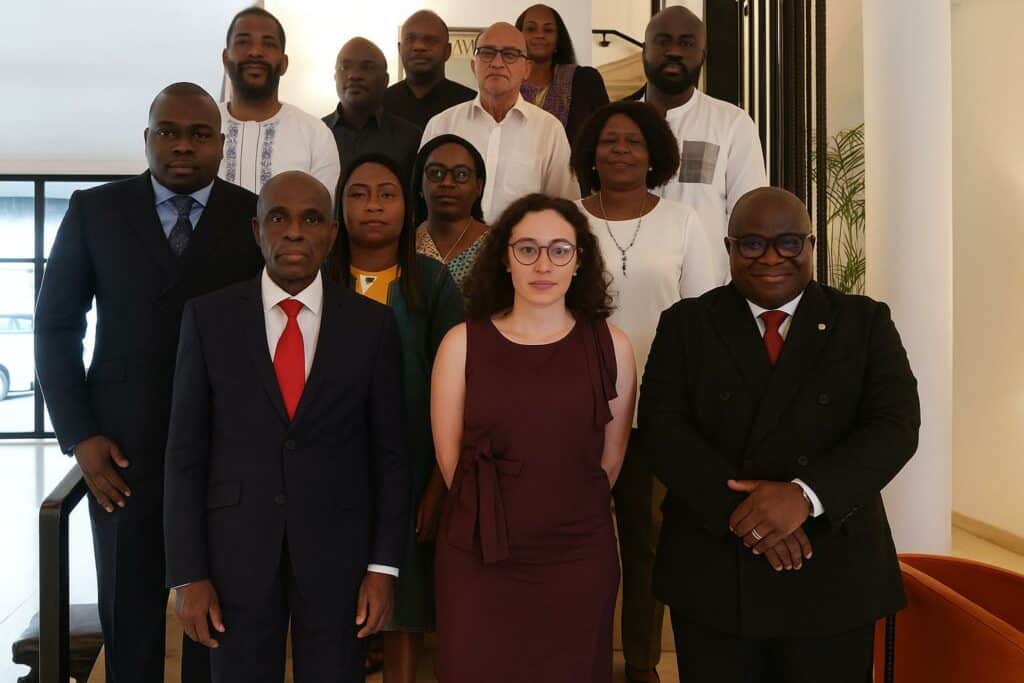A Regional Laboratory for Community Forestry
The cool morning of 14 October found thirty specialists from Congo-Brazzaville and Cameroon gathered in a discreet conference hall overlooking the Djoué River. Under the flag of the Project for Strengthening and Innovation in Participatory Forestry for the Benefit of Local Communities on the Edge of Protected Areas of the Congo Basin (RiFoP), they were tasked with assessing a concept that is raising expectations as much as questions: the “household agroforest”. Developed as a sub-component of RiFoP, the approach assigns clearly delimited forest plots to individual families or clusters of related households, who are then responsible for integrating timber, non-timber forest products and food crops under a single management plan.
Since 2021, demonstration sites have been monitored in northern Congo and in Cameroon’s East Region. Remote-sensing imagery, household surveys and ecological inventories constitute the project’s empirical backbone. The Brazzaville workshop, intended as the first regional stock-taking exercise, therefore carried the weight of anticipation among policy-makers and donors eager to identify scalable forest solutions in a zone that still loses approximately 0.2 percent of its canopy per year (FAO Forest Resources Assessment 2022).
Initial Data: Ecological Gains Outpace Social Uptake
Presentations converged on one reassuring point: plots managed under the household model exhibit a lower incidence of permanent clearing than neighbouring fallow systems. RiFoP’s lead ecologist, Dr Aurélia Biangola, reported a twenty-five percent reduction in burned surface over two dry seasons, alongside a stable density of valuable species such as Entandrophragma cylindricum. Soil moisture readings taken at the Makoua pilot site remained within agronomic thresholds despite successive El Niño events, suggesting that multi-strata canopies buffer microclimatic stress.
Yet the same datasets underscore socio-economic bottlenecks. Household labour peaks during planting and weeding seasons compete with off-farm income opportunities, particularly artisanal logging and urban migration. At the Cameroonian pilot in Mbang, only sixty-two percent of families maintained full plot records after the first year, down from an initial compliance rate of ninety-four percent. According to economist Judith Tchamkou, short-term cash flow “remains the Achilles’ heel of the model, because the first significant timber revenues arrive no earlier than year twelve.”
Navigating a Triptych of Laws
Much of the debate therefore moved from silviculture to law. The forestry codes of Congo (2020) and Cameroon (1994, under revision) recognise community forests, but do not explicitly name households as management entities. Land statutes, in turn, still privilege collective tenure, while agricultural regulations focus on crops rather than integrated tree-crop systems. Henri Ondongo, director of legal affairs at Congo’s Ministry of Forest Economy, highlighted that “the absence of a norm on intra-community allocation is a gap we can fill without reopening the entire code”.
Participants examined precedents in Côte d’Ivoire and Ghana, where cocoa agroforests benefit from usufruct certificates embedded in land legislation. A working group led by the Central African Forests Commission (COMIFAC) suggested drafting regional guidelines translating the household concept into uniform legal language, a move that could later facilitate carbon finance accreditation under the Architecture for REDD+ Transactions.
Community Agency and Gender Dynamics
Voices from civil society insisted that the debate not remain technocratic. Clarisse Badinga of the Congolese NGO Femme et Forêt argued that securing plots to nuclear families may, if badly designed, sideline women whose land rights are often mediated through customary lineage systems. She called for procedural safeguards such as joint titling and transparent conflict-resolution mechanisms. The plea resonated with Cameroonian village chief Jacques Abessolo, who noted that “households are fluid entities; marriage, inheritance and migration continually reshape them.”
RiFoP coordinators responded by announcing a new anthropological baseline study to be launched in early 2024. Its objective is to capture intra-household decision-making and to test whether profit-sharing rules could be linked to school fees or health expenditures, thereby converting long-term ecological benefits into visible social dividends.
Economic and Ecological Stakes for Congo
For Brazzaville, the stakes transcend experimental plots. Congo’s nationally determined contribution under the Paris Agreement aims for a forest-sector emission reduction of twenty-five million tonnes of CO₂ by 2030. Household agroforests, if mainstreamed over two million hectares of lightly degraded forest, could deliver up to fifteen percent of that target, according to preliminary modelling by the National Center for Forest Inventory. Furthermore, the model aligns with the government’s objective of diversifying rural economies while preserving environmental assets.
Minister of Agriculture, Livestock and Fisheries Paul Valentin Ngobo, addressing the workshop by video link, emphasised the political relevance of the pilot. He praised its “potential to reconcile agricultural intensification with the President’s vision of a green and resilient Congo”. Investors took note: the African Development Bank signalled interest in integrating household agroforestry into its forthcoming agro-industrial park programme.
Towards a Scalable Blueprint
Before the participants dispersed, four consensual milestones were inscribed in the draft road-map: complete an interdisciplinary evaluation of the current pilots; elaborate a harmonised legal annex endorsed by COMIFAC; mobilise blended finance to cover the transition lag between planting and first harvests; and develop a joint training curriculum for forest extension officers in both countries. The document, once validated, will circulate to ECCAS members, planting the seed for a potentially wider regional adoption.
While the first verdict on household agroforests is cautiously optimistic, the model remains at a crossroads. Its promise of ecological integrity and rural empowerment will materialise only if laws, markets and community norms converge. In the words of Dr Biangola, “we have proof of concept; the challenge ahead is proof of sustainability.” Brazzaville’s workshop has thus opened a diplomatic and technical corridor that could redefine community forestry across Central Africa, showing that small family plots may indeed hold a large part of the Congo Basin’s future.

